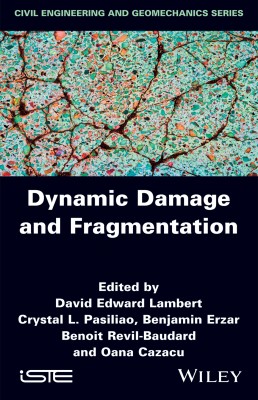
Edited by
David Edward Lambert, Air Force Research Laboratory, Munitions Directorate, Eglin, USA
Crystal L. Pasiliao, Air Force Research Laboratory, Munitions Directorate, Eglin, USA
Benjamin Erzar, Commissariat à l’Energie Atomique, Gramat, France
Benoit Revil-Baudard, University of Florida, REEF, Shalimar, USA
Oana Cazacu, University of Florida, REEF, Shalimar, USA
Engineering structures may be subjected to extreme high-rate loading conditions, like those associated with natural disasters (earthquakes, tsunamis, rock falls, etc.) or those of anthropic origin (impacts, fluid–structure interactions, shock wave transmissions, etc.). Characterization and modeling of the mechanical behavior of materials under these environments is important in predicting the response of structures and improving designs.
This book gathers contributions by eminent researchers in academia and government research laboratories on the latest advances in the understanding of the dynamic process of damage, cracking and fragmentation. It allows the reader to develop an understanding of the key features of the dynamic mechanical behavior of brittle (e.g. granular and cementitious), heterogeneous (e.g. energetic) and ductile (e.g. metallic) materials.
1. Some Issues Related to the Modeling of Dynamic Shear Localization-assisted Failure, Patrice Longère.
2. Analysis of the Localization Process Prior to the Fragmentation of a Ring in Dynamic Expansion, Skander El Maï, Sébastien Mercier
and Alain Molinari.
3. Gradient Damage Models Coupled With Plasticity and Their Application to Dynamic Fragmentation, Arthur Geromel Fischer
and Jean-Jacques Marigo.
4. Plastic Deformation of Pure Polycrystalline Molybdenum, Geremy J. Kleiser, Benoit Revil-Baudard and Oana Cazacu.
5. Some Advantages of Advanced Inverse Methods to Identify Viscoplastic and Damage Material Model Parameters, Bertrand Langrand, Delphine Notta-Cuvier, Thomas Fourest and Eric Markiewicz.
6. Laser Shock Experiments to Investigate Fragmentation at Extreme Strain Rates, Thibaut De Rességuier, Didier Loison, Benjamin Jodar,
Emilien Lescoute, Caroline Roland, Loïc Signor and André Dragon.
7. One-dimensional Models for Dynamic Fragmentation of Brittle Materials, David Cereceda, Nitin Daphalapurkar and Lori Graham Brady.
8. Damage and Wave Propagation in Brittle Materials, Quriaky Gomez, Jia Li and Ioan R. Ionescu.
9. Discrete Element Analysis to Predict Penetration and Perforation of Concrete Targets Struck by Rigid Projectiles, Laurent Daudeville,
Andria Antoniou, Ahmad Omar, Philippe Marin, Serguei Potapov and Christophe Pontiroli.
10. Bifurcation Micromechanics in Granular Materials, Antoine Wautier, Jiaying Liu, François Nicot and Félix Darve.
11. Influence of Specimen Size on the Dynamic Response of Concrete, Xu Nie, William F. Heard and Bradley E. Martin.
12. Shockless Characterization of Ceramics Using High-Pulsed Power Technologies, Jean-Luc Zinszner, Benjamin Erzar and Pascal Forquin.
13. A Eulerian Level Set-based Framework for Reactive Meso-scale Analysis of Heterogeneous Energetic Materials, Nirmal Kumar Rai
and H.S. Udaykumar.
14. A Well-posed Hypoelastic Model Derived From a Hyperelastic One, Nicolas Favrie and Sergey Gavrilyuk.
David Edward Lambert is a member of the scientific and professional cadre of Senior Executives, and Chief Scientist of the Air Force Research Laboratory, Munitions Directorate, Eglin, USA.
Crystal L. Pasiliao is a Senior Research Scientist at the Air Force Research Laboratory, Munitions Directorate, Eglin, USA.
Benjamin Erzar is a Senior Research Scientist at the Commissariat à l’Energie Atomique, Gramat, France.
Benoit Revil-Baudard is a Research Scientist in the Department of Mechanical and Aerospace Engineering at the University of Florida, REEF, Shalimar, USA.
Oana Cazacu is Professor in the Department of Mechanical and Aerospace Engineering at the University of Florida, REEF, Shalimar, USA.